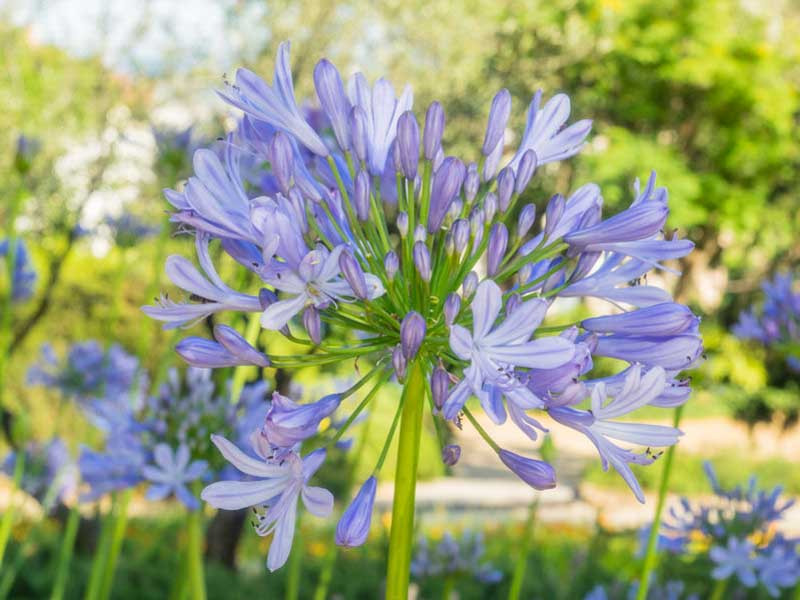Mastering the Art of Agapanthus Treatment: Necessary Actions for Healthy And Balanced Growth and Dynamic Flowers
In the realm of horticulture, the farming of agapanthus stands as a gratifying venture for those that look for to nurture these elegant flowering plants. With their striking blossoms and elegant vegetation, agapanthus has captured the focus of gardeners worldwide. Nonetheless, attaining ideal growth and vivid blooms calls for a nuanced technique that encompasses different vital actions. From picking the appropriate range to understanding pruning techniques, the journey towards growing prospering agapanthus plants is complex and holds the essential to unlocking the complete possibility of these agricultural treasures.
:max_bytes(150000):strip_icc()/agapanthus-growing-guide-7368912_06ba-bf1fa268243b451387986fbd1e2433b3.jpg)
Picking the Right Agapanthus Variety

When picking the appropriate Agapanthus selection for your garden, take into consideration aspects such as environment suitability, flower shade, and development habit. In addition, take into consideration the climate in your region to make certain the Agapanthus selection you pick can thrive in your details conditions. Understanding the growth behavior of various Agapanthus varieties is critical for proper positioning within your garden.
Perfect Planting Problems
Thinking about the optimum ecological demands is vital for effective Agapanthus cultivation. Agapanthus grows in well-draining dirt with a slightly acidic to neutral pH degree. When planting, pick a place that receives complete sunlight to partial shade. In hotter climates, supplying some afternoon shade can protect against scorching of the leaves. Agapanthus plants are delicate to cold temperature levels and need to be safeguarded from frost during winter season.
To make certain healthy growth and vivid blooms, plant Agapanthus bulbs at a depth of about 2-4 inches and room them 8-12 inches apart. Including raw material, such as compost, to the soil can enhance water drainage and fertility, promoting durable root growth. Mulching around the base of the plants helps preserve wetness and suppresses weed development. Normal watering is crucial, particularly during the expanding period, to maintain the soil regularly wet but not saturated.
Watering and Feeding Tips
Keeping proper moisture degrees and giving necessary nutrients are crucial elements in the treatment routine for Agapanthus plants. When it pertains to watering Agapanthus, it is crucial to strike a balance. These plants choose consistently moist soil yet are prone to root rot if overwatered. Throughout the growing period, water deeply once a week, guaranteeing the dirt is well-draining to stop waterlogging. In hotter environments or throughout durations of dry spell, more frequent watering may be necessary to keep the soil evenly moist. Nevertheless, minimize watering in the winter to stop waterlogged problems.
Feeding Agapanthus is essential for advertising healthy and balanced development and respected flowers. Use a balanced fertilizer, such as a 10-10-10 formula, in the very early spring as brand-new growth arises. Repeat this application every 6-8 weeks throughout the expanding period. Stay clear of too much fertilization, as it can result in lush vegetation like this at the expenditure of blossoms. Always follow the supplier's guidelines for proper dilution and application techniques. By adhering to these watering and feeding tips, you can ensure your Agapanthus plants grow and generate vibrant, lasting flowers.
Trimming Strategies for Agapanthus
Trimming Agapanthus plants at the ideal times and with proper techniques is crucial for preserving their wellness and advertising ideal development and blooming. The ideal time to prune Agapanthus remains in late winter season or very early springtime before brand-new development arises. Begin by removing any kind of dead or yellowing fallen leaves near the base of the plant. Cut them as short as feasible without harming the arising shoots.
Deadheading invested flowers can likewise reroute the plant's power right into producing more blossoms instead than establishing seeds. If you want to gather seeds for breeding, leave some look at more info flowers to fully grown and dry on the plant.
Keep in mind to make use of tidy, sharp tools to make accurate cuts and decrease the danger of introducing conditions. Agapanthus. Normal trimming will aid maintain your Agapanthus looking healthy and cool while making certain a plentiful display screen of lovely flowers
Handling Common Parasites and Illness
After ensuring proper trimming techniques for Agapanthus, it is important to resolve usual insects and conditions that can influence the health and wellness and vigor of these plants. One common parasite that influences Agapanthus is the Agapanthus this contact form gall midge.
One more typical concern is fungal fallen leave place, which provides as dark lesions on the leaves. To avoid fungal diseases, make certain excellent air flow around the plants, prevent overhead watering, and remove any infected leaves without delay. Additionally, Agapanthus plants can suffer from root rot if they are planted in poorly draining pipes dirt. To avoid this, plant Agapanthus in well-draining soil and prevent overwatering. By being cautious and taking punctual activity versus illness and insects, you can aid your Agapanthus plants grow and create vivid blooms.

Conclusion
To conclude, mastering the art of agapanthus treatment entails picking the ideal range, providing ideal planting conditions, correct watering and feeding, appropriate pruning strategies, and addressing typical insects and diseases. By adhering to these vital steps, you can ensure healthy growth and lively flowers for your agapanthus plants. Remember to regularly keep track of and preserve your plants to advertise their general health and durability.
To guarantee healthy development and dynamic blooms, plant Agapanthus bulbs at a depth of about 2-4 inches and area them 8-12 inches apart. By complying with these watering and feeding pointers, you can guarantee your Agapanthus plants grow and produce dynamic, durable flowers.
One common bug that influences Agapanthus is the Agapanthus gall midget. Furthermore, Agapanthus plants can experience from origin rot if they are grown in improperly draining pipes soil. By following these necessary steps, you can make sure healthy and balanced growth and dynamic blossoms for your agapanthus plants.
 Rider Strong Then & Now!
Rider Strong Then & Now! Dylan and Cole Sprouse Then & Now!
Dylan and Cole Sprouse Then & Now! Kane Then & Now!
Kane Then & Now! Barbara Eden Then & Now!
Barbara Eden Then & Now! Megyn Kelly Then & Now!
Megyn Kelly Then & Now!